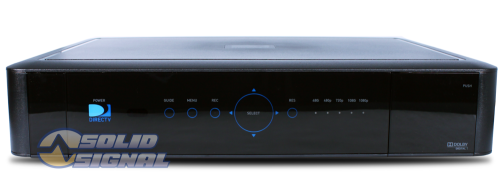As we all move from single-tuner and dual-tuner DVRs to new super DVRs like the DIRECTV HR34 Genie, our systems get more and more complex. Even if you’re not a hobbyist you might want to understand a little bit about how your system is wired and how to tell if you’ll have problems.
It’s called “tuner math” and it’s a little harder to understand that the way things were back 5 years ago. DIRECTV’s original wiring scheme had one wire for each tuner that was used. A receiver could tune only one thing, and had only one wire in. A DVR could tune two and had two wires in. You could use a simple multiswitch to add more tuners to your system.
That changed with SWM technology. SWM Technology was designed to let people use existing home wiring and make new installations easier. Many homes were built pre-wired with one cable per room, but DVRs required two. The new SWM (single-wire multiswitch) meant that no matter how many tuners were in use, you only need one wire. It also made it possible to use simple splitters to reconfigure your system rather than running another line to the dish. (Want to know more? Here’s a whole white paper explaining it.)
While SWM made wiring easier, it made understanding harder. Instead of counting the wires you have to count the tuners. It’s important because if you have too many tuners you will get error messages on your TV and you won’t be able to watch.
The basics of the system
Most people have a SWM-8, either built-in to the dish or as a separate part. That means they can have up to 8 tuners. Note that’s not 8 receivers, and probably not even 8 wires. This is tuner math. We don’t count the wires, we don’t count the boxes. We count the tuners.
- A regular receiver (non-DVR) counts as one tuner.
- An older DVR (like HR21, HR24, or TiVo) counts as two tuners. (It can record two things at once.)
- A Genie DVR (like HR34 and HR44) counts as five tuners. (It can record five things at once.)
- A C31 or C41 Genie Mini Client counts as zero tuners.
That last point takes a little explaining. The Genie mini client is not a receiver. It doesn’t do anything by itself. It gets all its information from the Genie DVR. So, it doesn’t count as a tuner. Also, the Broadband DECA or Cinema Connection Kit that connects your DIRECTV system to the internet doesn’t count as a tuner either, and neither does the power inserter.
You can only have 8 tuners in the average DIRECTV system. Here are some examples of GOOD setups that won’t give you any trouble:
- HR24, 6 H24s (8 tuners)
- HR20, 2 H21s, 2 D12s (6 tuners)
- HR34, HR24, H25 (8 tuners)
- HR34, 3 C31s (5 tuners… remember C31s don’t have tuners)
- HR34, 3 H23s, 3 C31s (8 tuners)
On the other hand, if you overload your system you may have problems. Even if the receivers are not turned on you can get errors on screen that will stop you from watching. The most common is Error 776. (Want to know what the others are? Click here.) Here are some examples of BAD setups:
- HR34, 2 HR24s (9 tuners)
- 2 HR34s (10 tuners)
- 8 HR24s (16 tuners)
- 9 D12s (9 tuners)
What if you need more than 8 tuners?
If you have a need for more than 8 and fewer than 16 tuners, you can upgrade to a SWM-16 multiswitch which will easily give you the ability to hook up 16 tuners and have them all communicate. If you need more than that, you need to read our exclusive guide… we’ll take you through it step by step.
If you have a SWM-16 it’s important to balance the lines. The multiswitch has ports labeled SWM1 and SWM2 and each can only support 8 tuners. You cannot put 9 tuners on one and 7 tuners on the other.
Ignore the number of wires and splitter ports.
With the new system the number of wires and splitter ports used has no bearing at all on the system. If you have a Genie DVR and one client, you can use a 2-port splitter even though there are 5 tuners in use. Also, because clients, power inserters and cinema connection kits don’t take up a tuner, you could have 11 or more wires coming from the dish but still only have 8 tuners in use.
Tuner math is a little tricky at first but once you get the hang of it, you’ll find it’s automatic.





